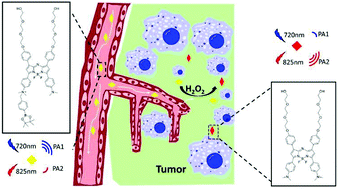Enhancing hydrophilicity of photoacoustic probes for effective ratiometric imaging of hydrogen peroxide†
Abstract
Hydrogen peroxide (H2O2) plays a significant role in regulating the redox balance in the living body. Compared with traditional imaging techniques, ratiometric photoacoustic imaging is no doubt a superior choice for H2O2 visualization. However, the difficult design of ratiometric probes with only one activatable agent that exhibits two changeable absorption peaks under H2O2 activation remains a big challenge. In this work, we developed a near-infrared absorbing probe, which responded to H2O2 selectively and permitted the ratiometric photoacoustic imaging of H2O2 in living mice. The probe was constructed from an Aza-BODIPY backbone attached with a benzeneboronic acid pinacol ester moiety though a quaternization reaction. Oligo(ethylene glycol) (OEG) was introduced into hydrophobic Aza-BODIPY to enhance the water-solubility of the probe. The OEG-Aza-BODIPY-BAPE probe exhibited sensitive and specific ratiometric PA signals towards H2O2. In vivo experiments also showed that the OEG-Aza-BODIPY-BAPE probe can be used for ratiometric PA imaging. Overall, our work illustrated a high sensitivity hydrophilic photoacoustic probe for ratiometric imaging of hydrogen peroxide in vitro and vivo.



 Please wait while we load your content...
Please wait while we load your content...